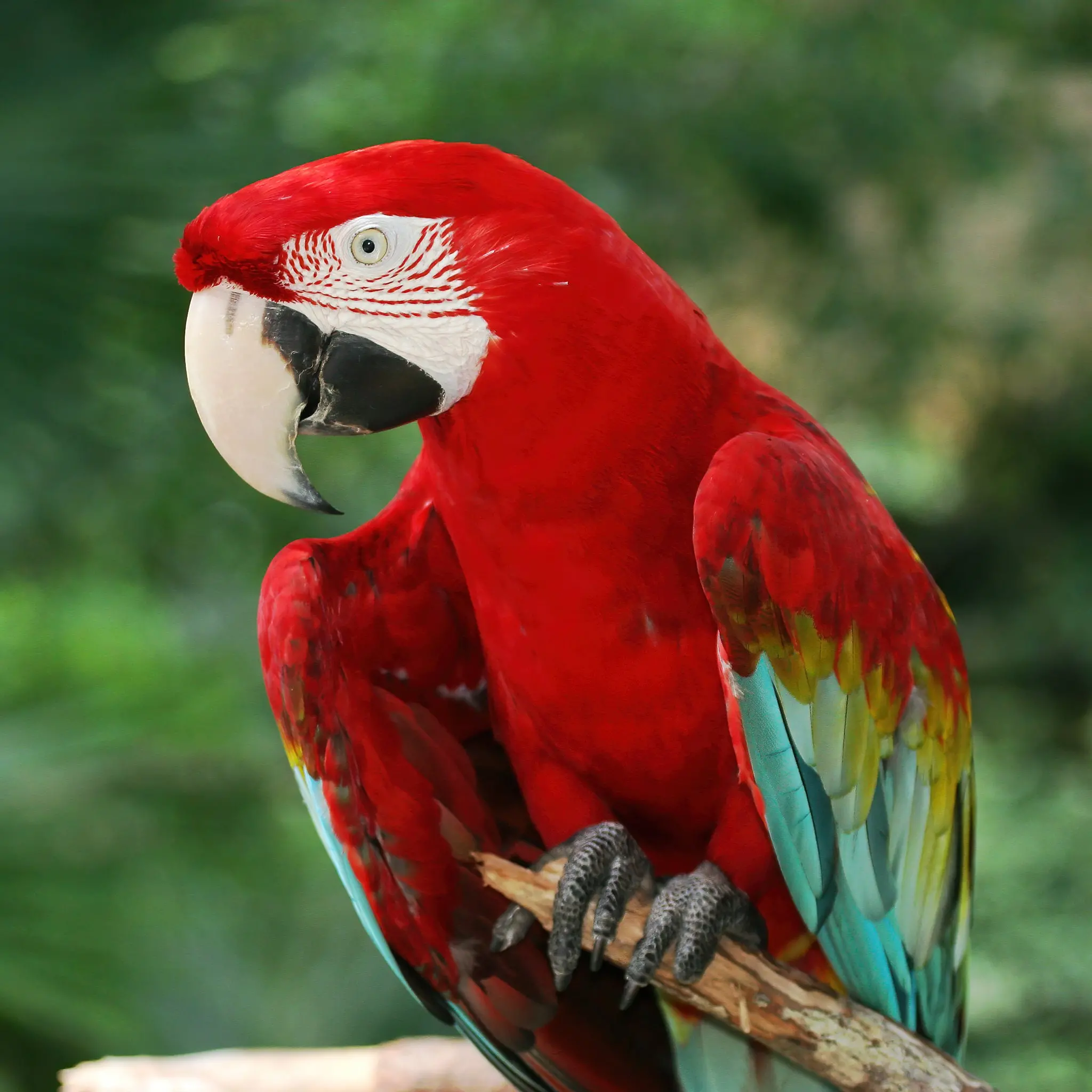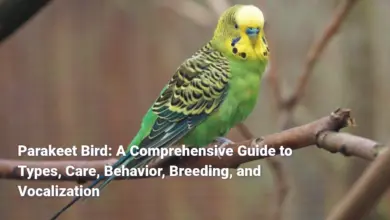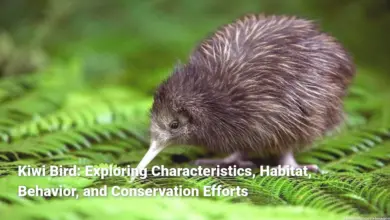Macaw Parrots: A Comprehensive Guide to Types, Lifespan, and Diet
A Detailed Overview of Macaw Parrots: Types, Lifespan, and Nutritional Requirements
Macaw Parrots, those magnificent, vibrantly colored birds, embody the beauty and charm of avian life. With their long tails, bold plumage, and striking personalities, these parrots have captivated enthusiasts and bird lovers around the globe. From their complex social structures to their unmistakable vocalizations, Macaw Parrots are fascinating creatures that thrive in the lush ecosystems of Central and South America. Yet, their appeal goes beyond mere aesthetics; they are intelligent and social animals requiring substantial care. This comprehensive guide will delve into the various types of Macaw Parrots, their diets, habitats, lifespans, care as pets, reproduction, and popular species, revealing the many layers of what makes these parrots exceptional.

As we explore this guide, you will come to learn about the diverse macaw species, such as the stately Hyacinth, the striking Scarlet, and the playful Blue and Gold macaws. You will also discover how their lifespans in the wild differ from those in captivity, highlighting the importance of proper care for these intelligent creatures. Understanding their dietary needs, natural habitats, nesting preferences, and the challenges of ownership will equip you with the knowledge to appreciate macaws not only as pets but also as vital members of their ecosystems.
Types of Macaw Parrots
Macaws are categorized into several groups based on their size, coloration, and characteristics. Akin to a palette of colors spilled across the South American rainforests, the different types of macaws showcase a rich diversity that reflects their adaptation to various environments.
- Large Macaws:
- Hyacinth Macaw
- Scarlet Macaw
- Great Green Macaw
- Military Macaw
- Blue and Gold Macaw
- Green-Winged Macaw
- Mini Macaws:
- Hahn’s Macaw
- Illiger’s Macaw
- Severe Macaw
- Yellow-Collared Macaw
- Hybrid Macaws: Unique hybrids such as:
- Ruby Macaw (Scarlet x Green-Winged)
- Catalina Macaw (Scarlet x Blue and Gold)
These categories allow enthusiasts and potential pet owners to appreciate the traits and requirements of each type of macaw. While large macaws tend to be more vibrant and social, mini macaws offer similar traits but in a smaller size that can better fit certain living spaces. Hybrids boast interesting colorations and personalities, making them sought after in the pet market, albeit with varying care needs.
Large Macaw Parrots
Large macaws are recognizable for their size, vivid colors, and playful demeanor. Typically measuring between 30-40 inches in length and weighing from 2 to 4 lbs, these macaws bring the vibrancy of the rainforest directly to your living room.
1. Hyacinth Macaw (Anodorhynchus hyacinthinus)
- Size: 3.3 – 3.5 feet long
- Weight: 2.5 to 4 pounds
- Life Expectancy: Up to 50 years in captivity
- Colors: Bright cobalt blue with yellow eye patches
The Hyacinth Macaw is the largest flying parrot, gracing us with its stunning cobalt blue feathers and an affectionate disposition. They can display a gentle and inquisitive nature, making them suitable for experienced owners who can provide both social interaction and mental stimulation.
2. Scarlet Macaw (Ara macao)
- Size: Approximately 3 feet long
- Weight: 2-3 pounds
- Life Expectancy: 40+ years
- Colors: Bright red, blue, and yellow plumage
Steeped in vibrant hues, the Scarlet Macaw captures the essence of the rainforest. Known for their playful and social nature, they thrive in interactive environments, making them excellent companions if one can handle their sometimes demanding behavior.
3. Blue and Gold Macaw (Ara ararauna)
- Size: About 3 feet long
- Weight: 2 to 2.5 pounds
- Life Expectancy: 30-35 years
- Colors: Striking blue wings and a bright yellow underside
This species is typically a little quieter than their Scarlet counterparts, yet equally affectionate and lively. Known for their strong vocal abilities, Blue and Gold macaws are loved for their playful antics and sociability.
4. Green-Winged Macaw (Ara chloroptera)
- Size: Approximately 3 feet
- Weight: 2.5 to 3 pounds
- Life Expectancy: 50+ years
- Colors: Red forehead and green body
These macaws display a unique mix of color and personality, thriving on social interaction and mental stimulation with their human companions and within their habitats.
| Species | Size (Approx.) | Weight (Approx.) | Lifespan (Captivity) |
|---|---|---|---|
| Hyacinth Macaw | 3.3 – 3.5 ft | 2.5 – 4 lbs | Up to 50 years |
| Scarlet Macaw | 3 ft | 2 – 3 lbs | 40+ years |
| Blue and Gold Macaw | 3 ft | 2 – 2.5 lbs | 30 – 35 years |
| Green-Winged Macaw | 3 ft | 2.5 – 3 lbs | 50+ years |
These stunning birds reflect the ecological diversity of their environments and underscore the commitment required for their care.
Mini Macaws
Mini macaws, while smaller than their larger relatives, bring the same charm, intelligence, and vibrancy in a more compact form. Averaging about 10 to 18 inches, these delightful birds capture the hearts of many enthusiasts who prefer a more manageable size without sacrificing character and personality.
1. Hahn’s Macaw (Ara nobilis nobilis)
- Size: Approximately 12-13 inches
- Weight: 5-7 ounces
- Life Expectancy: Up to 30 years
Hahn’s macaws are spirited little companions, known for their friendly nature and playful curiosity. They excel in interactive environments, offering delightful companionship for dedicated owners.
2. Illiger’s Macaw (Ara maracana)
- Size: About 12-13 inches
- Weight: 7-10 ounces
- Life Expectancy: 20-30 years
These vibrantly colored macaws excel in socialization and are known to bond closely with their human companions. Their charming personalities bring plenty of joy into any home.
3. Yellow-Collared Macaw (Ara auricollis)
- Size: Approximately 12-14 inches
- Weight: 5-8 ounces
- Life Expectancy: Around 30 years
Distinguished by their unique coloration and lively disposition, Yellow-Collared Macaws thrive on engagement and stimulation in their environments.
| Mini Macaw Species | Size (Approx.) | Weight (Approx.) | Lifespan (Captivity) |
|---|---|---|---|
| Hahn’s Macaw | 12-13 in | 5-7 oz | Up to 30 years |
| Illiger’s Macaw | 12-13 in | 7-10 oz | 20-30 years |
| Yellow-Collared Macaw | 12-14 in | 5-8 oz | Around 30 years |
Mini macaws are a fantastic choice for individuals or families looking for a smaller feathered companion that embodies the essence of a big macaw.
Hybrid Macaws
Hybrid macaws are the offspring produced by breeding two different macaw species, resulting in distinctive color variations and potential behavioral traits. Much like a painter blending colors to create something entirely new, hybrid macaws showcase the best of both parent species while introducing unique traits.
1. Ruby Macaw
- Parents: Scarlet and Green-Winged Macaw
- Characteristics: Typically showcases a stunning blend of vibrant red and green plumage, known for their intelligence and affectionate nature, making them popular among bird enthusiasts.
2. Catalina Macaw
- Parents: Scarlet and Blue and Gold Macaw
- Characteristics: Commonly features a beautiful gradient of red, blue, and gold in its plumage, these macaws are admired for their striking appearance and ability to form strong bonds with their caregivers.
3. Camelot Macaw
- Parents: Scarlet Macaw and Catalina Macaw
- Characteristics: A second-generation hybrid known for its stunning colors and lively personality, sharing many traits with its parent species.
| Hybrid Macaw | Parent Species | Notable Traits |
|---|---|---|
| Ruby Macaw | Scarlet x Green-Winged | Vibrant red and green coloring; affectionate |
| Catalina Macaw | Scarlet x Blue and Gold | Striking mix of red, blue, and gold hues |
| Camelot Macaw | Scarlet x Catalina | Beautiful colors; lively personality |
Hybrids can offer prospective owners a unique and colorful companion, often requiring dedicated care and commitment. Their distinctiveness comes with a need for special consideration in training and socialization, ensuring they have engagements that allow them to thrive.
Macaw Parrots Lifespan
Understanding the lifespan of macaws provides crucial insights into the long-term commitment these birds require. Generally, in the wild, macaws have an average lifespan of 25 to 50 years, significantly influenced by factors like habitat quality, food availability, and threats such as predators and diseases.
- Lifespan in the Wild
- Larger species, like the Hyacinth Macaw, might live up to 50 years, while smaller species may live shorter lives typically ranging between 10 and 30 years. For example, the Blue-headed macaw lives up to 10 years, while the Noble macaw often reaches 30 years delving into their ecological niches, survival skills, and social dynamics play substantial roles in shaping their longevity.
- Lifespan in Captivity
- Macaws, when kept as pets, can live significantly longer. Due to a lack of natural predators, better nutrition, and veterinary care, captive macaws can boast life expectancies that exceed 60 years. In some cases, reports of individuals surpassing 80 years are documented, with the oldest recorded living to 114 years. This enhanced lifespan necessitates careful consideration by prospective owners to understand the long-term responsibility they are undertaking.
| Lifespan | In the Wild | In Captivity |
|---|---|---|
| Blue-headed | Up to 10 years | 20-30 years |
| Scarlet | 40-50 years | 70 years |
| Hyacinth | Up to 50 years | Up to 60+ years |
The profound difference in longevity between wild and captive macaws highlights the necessity of providing the right living conditions and care to ensure that they thrive throughout their life span.
Lifespan of Macaw Parrots in the Wild
In their native tropical habitats, macaws face myriad challenges that impact their lifespans. For instance, the food supply, predation, and diseases play pivotal roles.
- Diet and Food Availability: Wild macaws depend on the seasonality of food sources like fruits, nuts, and seeds. Scarcity can lead to malnutrition, affecting health and lifespan.
- Predation and Threats: Natural predators and human encroachment, due to habitat destruction, poaching, and the illegal pet trade, pose serious threats. Macaws are often targeted for their feathers and beauty, leading to declining wild populations.
- Social Structures: Macaws are social creatures that often live in pairs or small flocks. Their ability to engage socially contributes positively to their overall well-being.
With these environmental factors in play, wild macaws demonstrate incredible adaptive skills, but they inevitably face challenges that affect their average lifespans.
Lifespan of Macaw Parrots in Captivity
Conversely, captive macaws lead very different lives, often exceeding their wild counterparts’ lifespans. The advantages include:
- Veterinary Care: Routine check-ups allow for early detection and treatment of diseases, significantly impacting overall health.
- Controlled Environment: Captivity limits exposure to predators and environmental stressors while providing a more stable living environment.
- Nutritional Needs: Proper diets formulated for macaws can enhance their health, contributing to their prolonged life.
| Species | Lifespan in Captivity |
|---|---|
| Blue-headed macaw | 20-30 years |
| Scarlet macaw | 70 years |
| Hyacinth macaw | Up to 70 years |
| Green-winged macaw | Up to 70 years |
The difference between lifespans highlights the importance of providing proper care and fostering healthy living conditions for macaws in captivity. This understanding aids owners in maintaining their macaws’ quality of life over the years.
Macaw Parrot Diet
A well-rounded diet is essential for macaws, contributing to their overall health, vibrancy, and longevity. In the wild, their varied diet evolves from diverse tropical ecosystems, but a proper diet in captivity ensures they receive adequate nutrition.
Typical Diet of Macaw Parrots in the Wild
Macaws are predominantly omnivorous, thriving on a balanced diet that includes:
- Fruits: Primary staple includes tropical berries and palm fruits, offering essential vitamins and carbohydrates for energy.
- Nuts and Seeds: Vital nutritional components providing healthy fats and proteins. Nuts such as Brazil nuts are favorites amongst many macaw species.
- Insects and Snails: Occasionally, wild macaws consume insects and snails for protein, particularly during breeding seasons, supplementing their diet with this necessary nutrient.
- Clay: Interestingly, macaws often visit clay licks, which provide crucial minerals that help in detoxifying certain plant compounds and promoting digestive health.
Understanding their wild dietary habits enables owners to ensure a balanced diet while accounting for the necessary vitamins and nutrients.
Common Foods Consumed by Macaw Parrots
In captivity, it’s essential to replicate a macaw’s natural diet as much as possible to promote health and longevity. Foods commonly recommended include:
- High-Quality Pellets: These should form the foundation of their diet, ensuring they receive adequate macro and micronutrients.
- Fresh Fruits and Vegetables: An array of fresh produce such as carrots, apples, and greens provide essential vitamins and a variety of textures to keep their diet interesting.
- Nuts and Seeds: While delicious, these should be given in moderation due to high-fat content, ensuring a well-rounded dietary approach.
- Special Treats: Occasionally, integrating nuts or exotic fruits can keep their interest in their diet; however, moderation is key to avoid health issues.
| Food Type | Wild Sources | Captive Recommendations |
|---|---|---|
| Fruits | Tropical berries and palms | Apples, berries, bananas, etc. |
| Nuts | Various tropical nuts | Walnuts, almonds, pecans |
| Seeds | Seeds from various plants | High-quality bird seed mixes |
| Insects/Snails | Naturally occurring | Insects as occasional treats |
| Clay | Clay licks along rivers | Not applicable to captivity |
Ensuring a balanced and varied diet is crucial to the well-being of macaws, emphasizing that owners commit to maintaining the nutritional needs of their feathered friends.
Nutritional Needs of Macaw Parrots
Providing an enriched diet is pivotal to the health of macaws, encompassing:
- Balanced Pellets: High-quality pellets should make up 70-80% of their diet, offering necessary nutrients.
- Fresh Produce: Fresh fruits and vegetables provide vitamins, aiding in digestion and health. Kale and carrots are excellent additions.
- Healthy Fats: Incorporating healthy fats through nuts and seeds supports energy levels and overall wellness, but this must be moderated to prevent obesity.
- Hydration: Clean water should always be provided for drinking and bathing, as hydration is vital for macaw health.
By maintaining a conscientious approach to their nutrition, owners can contribute significantly to their macaws’ quality of life and longevity.
Macaw Parrots Habitat
Macaws thrive in specific habitats that cater to their dietary and environmental needs. Understanding their natural habitats allows enthusiasts to create a more suitable environment when keeping them as pets.
Natural Habitats
Primarily, macaws are found in tropical rainforests and open wooded areas. Their specific habitat preferences vary:
- Tropical Lowland Rainforests: Most common for larger macaw species, providing ample food resources and nesting sites within their dense canopies.
- Savannah and Open Woodland: Certain species adapt to these environments, which allow for foraging and nesting opportunities in different geographic locations.
- Rivers and Mangrove Vegetation: These areas serve as crucial feeding and drinking sites, benefiting hydration and nutrition.
Geographic Distribution
Macaws range across Central and South America, exhibiting adaptability in various ecosystems.
- Amazon Rainforest: A primary region for macaws, providing rich biodiversity that supports their diets and overall well-being.
- Andes Mountains: Coastal and mountainous regions of South America showcase diverse habitats suitable for different bonfactors of macaw species.
| Habitat Type | Examples | Macaw Species Found |
|---|---|---|
| Tropical Rainforests | Amazon, Congo Basin | Scarlet, Hyacinth, Green-Winged |
| Open Woodland | Central Brazil, Paraguay | Blue and Gold, Military |
| Coastal Mangroves | Caribbean Regions | Scarlet, Blue-throated |
Macaw populations rely on healthy habitats to thrive, highlighting the importance of conservation efforts to ensure their survival in the wild.
Nesting Preferences
Macaws exhibit distinctive preferences for nesting, significantly impacting their reproductive success.
- Nesting Sites: They typically opt for tree cavities in tall trees between 30-50 feet high, providing safety from terrestrial predators and ample visibility.
- Nesting Materials: Twigs, leaves, and soft bark create a comfortable and secure environment for raising their young. Many species return to the same nesting location annually, demonstrating strong attachments.
In captivity, owners should consider their nesting preferences, offering spacious environments that cater to their instincts while promoting safe and secure spaces.
Macaw Parrots as Pets
Macaws can make engaging and rewarding pets, but their care necessitates a significant commitment. They require attentive and knowledgeable owners who can meet their social, dietary, and environmental needs.
Care Requirements
Successful macaw ownership involves fulfilling various care requirements, including:
- Diet: As previously discussed, a balanced diet is essential for maintenance and longevity.
- Housing: A spacious cage with plenty of room to move and toys to explore prevents boredom and enhances physical health.
- Social Interaction: Macaws are highly social creatures and require regular interaction. Owners need to spend ample time engaging in play, training, and socialization.
- Health Monitoring: Routine veterinary check-ups are vital, taking proactive measures to maintain their health.
Training and Socialization
Training macaws, while rewarding, can also be challenging. The following points should be considered:
- Positive Reinforcement: Techniques utilizing treats and praise can foster good behavior, enhancing their learning capacity.
- Social Interaction: Regular exposure to different individuals and environments helps to ensure they remain well-adjusted and sociable.
- Behavior Management: Being aware of their vocalizations and behaviors can help address potential behavioral issues, leading to a happier, healthier pet.
Creating a structured environment, where training and socialization are prioritized, is key to nurturing a well-behaved companion.
Challenges of Ownership
Owning a macaw also comes with several challenges that should not be overlooked:
- Noise Levels: Loud vocalizations can be a concern, especially in smaller living spaces or apartment settings.
- Destructive Behaviors: Macaws like to chew, and without proper toys, they may resort to damaging furniture and other household items.
- Long Lifespan: A macaw’s long lifespan requires owners to think long-term about their caregiving commitments.
- Space Requirements: Large cages and plenty of time outside the cage for exercise are essential for their well-being.
By being mindful of these elements, prospective owners can make informed decisions about welcoming a macaw into their lives.
Macaw Parrots Reproduction
Macaw reproduction involves complex behaviors and requirements, with nesting and parental care being vital for the survival of their young.
Mating Habits
Macaws typically engage in elaborate courtship behaviors, which are critical in the formation of lifelong bonds between partners. Points to note include:
- Courtship Displays: Mutual preening and impressive aerial displays serve to strengthen pair bonds and show readiness for mating.
- Breeding Season: Generally occurring during warmer months, this variability allows them to take advantage of abundant food supplies for raising their chicks.
Nesting and Egg Laying
Nesting conditions often dictate successful reproduction:
- Nesting Locations: Macaws prefer cavities in high trees to avoid predators while nesting.
- Egg Laying: Females typically lay two to four eggs per clutch, relying on both parents for feeding and protection during this period.
After hatching, chicks usually remain in the nest for the initial months before fledging, relying fully on their parents for sustenance.
Raising Offspring
Caring for the young involves:
- Parental Care: Both parents play significant roles in feeding and protecting their young from predators. They provide a diet rich in fruits and nuts.
- Fledgling Period: After about three months, chicks begin to learn how to fly, after which they continue to rely on their parents for additional time before gaining independence.
Promoting successful breeding and rearing practices is essential, both in the wild and in captivity. Understanding these nuances allows for better care in breeding programs aimed at protecting and preserving macaw species.
Popular Macaw Parrots Species
Among the many types of macaws, three species stand out for their popularity and distinctive characteristics.
Scarlet Macaw
The Scarlet Macaw’s brilliant plumage and engaging personality have made it a favorite among bird enthusiasts.
- Physical Features: Its bright red feathers contrasted by yellow and blue accents on its wings make it a remarkable sight. They measure 32 to 36 inches long.
- Behavior: Highly social, these macaws require consistent social interaction and thrive when engaged with their owners.
Blue and Gold Macaw
Characterized by its striking blue and yellow feathers, the Blue and Gold Macaw is particularly well-regarded.
- Physical Features: Measuring approximately 30 to 34 inches long, their vibrant coloration and gentle demeanor capture attention.
- Behavior: Known for being friendly and more docile compared to their louder counterparts, they appreciate social interaction and mental stimulation.
Hyacinth Macaw
As the largest macaw, the Hyacinth holds a special place in bird enthusiasts’ hearts for its impressive size and affinity for companionship.
- Physical Features: With an impressive length of up to 3.5 feet, it displays vivid cobalt blue feathers alongside a striking yellow-orange eye ring.
- Behavior: Affectionate and gentle, these macaws develop strong attachments to their owners but require consistent social frameworks and spaces for exercise.
| Species | Physical Characteristics | Lifespan in Captivity |
|---|---|---|
| Scarlet Macaw | Bright red, yellow, and blue plumage | 40-50 years |
| Blue and Gold Macaw | Blue wings with a yellow underside | 30-35 years |
| Hyacinth Macaw | Cobalt blue with yellow eye patches | 60-80 years |
Each of these popular species exemplifies the beauty and diversity of macaws, showcasing why they remain a staple in aviculture and among bird enthusiasts.
The journey through the world of macaws illustrates these magnificent birds’ beauty, complexity, and intrinsic value. From their striking colors and engaging behavior to their varied diets and habitat preferences, macaws offer a window into the wonder of avian life and the ecological systems they inhabit. As aware and informed pet owners, we can ensure that macaws continue to flourish both in the wild and as cherished companions.









